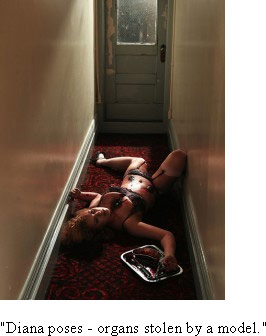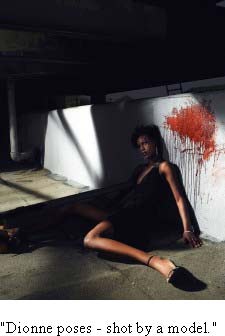Australia’s Next Top Model rates well. Really well. In fact, last year the premiere of series five entered the record books and became the most watched show on pay TV. Many of the viewers are teen girls and many of the contestants are teen girls. This year, of the 16 contestants, only two are out of their teens and the average age is just 17.
What type of messages will girls be exposed to if they tune in this year? Past offerings give us something to go on …
In 2007, the American version set the tone with one of the most alarming and tasteless episodes I have ever seen. The models were asked to pose as victims of violent crimes for a fashion shoot. They were depicted shot, bashed, pushed down stairs - the images were graphic and deeply disturbing. But apparently, this graphic glorification of violence against women is so hot right now.
Advertisement
The judges made remarks like: “What’s great about this is that you can also look beautiful in death” and “Death becomes you, young lady”. Even more disturbingly, the “victims” were all meant to have been killed by other models, so vicious was the contestants’ desire to win that they would kill the others to secure the coveted prize. The scenario of one of the pictures was so over the top that it would have been laughable if it wasn’t so creepy: “Diana poses - organs stolen by a model”. What was the other model meant to have done with the stolen kidneys? Sold them for Prada?


In 2008, the Australian series was rocked by (read: the show grabbed free publicity and maximised its audience with) awful bullying. Contestant Alamela Rowan, the victim of verbal taunts and physical attacks, was left quite distraught. So bad did the systematic intimidation become that the show’s judges at the time - Jodhi Meares, Charlotte Dawson and Alex Perry - reprimanded the other contestants, but no further action was taken and the bullies weren’t punished. This sparked a media debate on teen girl bullying, although the show’s culture of “compare and despair” and practice of ranking girls on their looks was not called into question. The main bully, Demelza Reveley, ended up winning the series and going on to receive the lucrative modelling contract - there, that showed her, didn’t it?
Throughout the seasons, the judges themselves have sometimes been less than ideal role models. Alex Perry has a reputation for doling out harsh criticism, calling contestants things like “wild pig”. Charlotte Dawson sends mixed body image messages. She now says she regrets some of the cosmetic surgery she has had, and that “anyone thinking plastic surgery will make them happier is wrong”. However, although she says she’s given up on invasive surgery, she does still use some cosmetic procedures. And she has a damning, dismissive and totally out-of-touch attitude towards plus-size models.
Advertisement
Last year saw a revolution of sorts, when a “plus-sized” model, Tahnee Atkinson, won. She was a size 10. I say this was a “revolution of sorts” as the average Australian woman is a size 16. It was hardly an earth-shattering move, was it? Yet many commentators asked if she was really top model material:
In an ideal world, yes. The girl is unquestionably gorgeous - she’s got an exceptional figure and a smile that stops traffic. She’s professional, well-behaved and determined. Her “normal” beauty is something that a lot of women would love to see more of in fashion magazines. But in the fickle and unfair world of modelling it probably won’t equal a long-term fashion career. As casting agents politely explained in the show, she just doesn’t have the matchstick-thin figure required by most top designers. Georgia Waters, Brisbane Times
What about this season then, post Tahnee, post the government’s Body Image Advisory Group? Don’t hold your breath that this season the show will suddenly adopt the new voluntary code of conduct for the fashion industry and begin to promote a diversity of sizes. In the first episode of the new season, airing tomorrow, viewers will see a 16-year-old contestant get excluded from a catwalk parade because she is “too big”. She’s a size 8. She says the experience left her feeling embarrassed and shamed into changing her eating habits. I spoke about this recently with Kerri-Anne Kennerley:
The new season has a ridiculous promo ad featuring models competing like racehorses - or are they greyhounds? - on a race track, trying to outrun one another to snatch the lure, i.e., the modelling contract. Women as thoroughbreds. And there is Sarah Murdoch with the starter’s gun. Sarah, I think your heart was in the right place when you joined the government-appointed body image advisory group. You were no doubt already a busy woman, successful and influential in your own right, so why would you join it other than because you believe action is needed to improve young people’s body image? However, perhaps you failed to realise that it was not a one-off gig, but an ongoing commitment to showing how things could be done differently in the fashion industry. Whether it is your intention or not, you are a role model. Sorry, but we expected more. I believe the rest of the advisory group did, too, and I hope they make a statement on the fact that messages in Australia’s Next Top Model contravene many of the group’s recommendations.
If you haven’t guessed by now, Australia’s Next Top Model isn’t my favourite show. But before anyone is tempted to outright ridicule it in front of teen girls who avidly watch it - or try to ban them from watching it - I want to say that I see a danger in demonising something that teen girls are interested in. From working with girls all around the country, I know that huge numbers of them dream of becoming a model, which is why in previous posts I’ve tried to take an objective look at modelling. Coming down too hard on girls for being interested in modelling or wanting to watch Australia’s Next Top Model is probably one of the least effective ways to minimise the potential damage. It makes us look out of touch, and that can put us on the back foot. It makes us look dismissive, and nothing is more frustrating to a teen girl than when adults act as if she doesn’t have a brain. And the best way to get a teen girl to watch something is to say we hate it and she isn’t allowed to watch it.
Goodness knows, as a teen girl I was obsessed with some shows I can look back at now and recognise as being rubbish - Prisoner anyone? And I remember that my friends and I were not just passive absorbers of those shows. Actually, we’d sit in front of Prisoner, loving every minute of it, but relentlessly poking fun at it, deconstructing the ridiculous things the characters did and said. To me, TV has always been an interactive medium, and I think it should be for all girls! The best thing we can do is encourage girls to deconstruct media messages, and that means getting a conversation going about Australia’s Next Top Model. Avoid the temptation to lecture, but instead ask questions about what the show tells us about the fashion industry and the media.
- Is it fair that we are all meant to aspire to a narrow beauty ideal?
- How achievable is that ideal?
- Does anyone truly win when girls compete against one another based solely on appearance?
- These are real teen girls on the screen, not made-up characters. Is it okay that they face this type of criticism and judgment for others’ entertainment?
What other questions do you think would be worth raising with girls in order to encourage them to see past the fashionista hype?